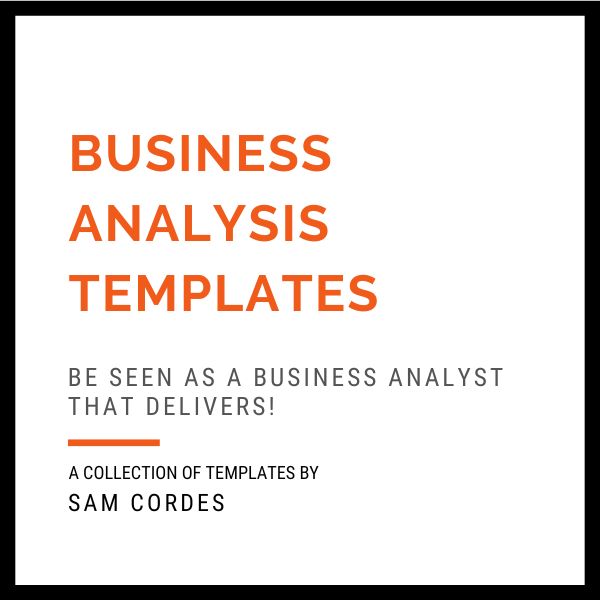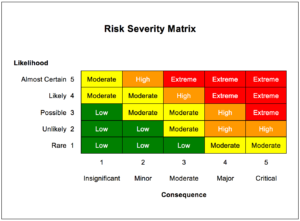Business Case Options
If you’re developing a business case where several technology options and implementation approaches are being assessed it’s highly recommended that you have a structured method for recommending the best approach forward. The benefits of having a structured method is:
- It takes the confusion out of assessing multiple solutions and approaches, and
- The final recommendation made to decision makers is based on solid verifiable analysis.
In this post I will show you a powerful method for developing assessment criteria for scoring a range of implementation options. I will guide you through an example which is based on a business case for assessing four broad options.
Impress both your team and your clients!
Looking to streamline your business analysis process and produce high-quality work more efficiently? Check out this collection of customisable business analysis templates! With a range of templates to choose from, you can be sure to find the perfect solution for your needs and take your analysis to the next level.
VIEW COLLECTIONThe options are:
Option 1: Do Nothing. This option proposes to undertake no change and maintain the current status with the existing systems and processes.
Option 2: Utilise Existing Investment. This option proposes to utilise existing technology available within the organisation. There may be several existing solutions available and each one needs to be assessed individually.
Option 3: Purchase a Solution. This option proposes to purchase a commercially available product. There may be several products available and each one needs to be assessed individually.
Option 4: Custom Build. This option proposes to fully develop a customised solution from the “ground up”.
The four broad options represent an implementation approach. However, within options two and three (and four!) there could be several available technology solutions that require assessment.
Solution Assessment Criteria
To assist with developing a recommendation for the implementation of a system, predefined assessment criteria can be developed whereby weighted scores are assigned to each criterion for each technology solution. The assessment criteria must be determined by the key stakeholders and decision makers in the organisation.
The assessment criteria may be, but not limited to, the following examples:
Requirements coverage,
Contract value,
Implementation timeframe,
Ongoing cost, and
Risk.
The higher a technology option scored, the better it rated as a candidate system for implementation.
Requirements Coverage
Each technology solution identified in the business case can be assessed for compliance with the business and technical requirements of the proposed system.
There will be many requirements documented from the requirements gathering phase. I’m assuming that the bulk of the most important requirements are known at this stage. Each identified technology solution will need to be checked against every requirement to determine whether the solution can provide adequate requirements coverage. A method for doing this uses the following criteria:
SUP = Supported (i.e., the requirement is supported by out-of-the-box functionality)
CFG = Configurable (i.e., the requirement is supported by a functional component that requires time spent on configuration)
CST = Customisation Required (i.e., the requirement is not supported by default and requires time spent on custom development)
FUT = Future Inclusion (i.e., the requirement is not currently supported and functionality is being developed for future release)
NS = Not Supported (i.e., the requirement is not supported by current or future releases)
3RD = Third Party (i.e., the requirement is supported via integration with a third-party product)
Scores are given to each option based on critical requirements coverage. For example,
3 = All requirements are met by the technology solution
2 = Requirements are partially met by the solution
1 = Requirements are not met by the technology solution
Due to the level of importance that the system meets the organisation’s business requirements, the Requirements Coverage criterion can be determined to be twice as important as the other assessment criteria in the overall analysis. Therefore, each technology solution may be given (this is optional) the following final scores:
6 = All requirements are met by the technology solution
4 = Requirements are partially met by the solution
2 = Requirements are not met by the technology solution
Contract Value
In the case where it’s intended to purchase and/or implement a system, the contract value may be a important criteria for assessment. Therefore, on the basis of indicative costs provided by each vendor or supplier, the contract value for the first two years (arbitrary timeframe) of system purchase and implementation can be estimated, and each technology solution given a score as shown in the example below:
3 = Low (under $550,000, the preferred budget constraint)
2 = Medium (between $550,000 and $1.1m)
1 = High (over $1.1m)
Implementation Timeframe
Each technology solution can be assessed against timeframe for implementation from the date of acquisition. Timeframes may be categorised as:
3 = shortest timeframe for implementation (under 6 months)
2 = medium timeframe for implementation (6 to 9 months)
1 = longest timeframe for implementation (9 to 12 months)
It may be that the amount of customisation and configuration required of the technology solution to meet organisation’s system requirements is a predominant factor that will affect the timeliness of system implementation.
Ongoing Cost
The ongoing cost of each technology solution can be rated by software maintenance costs and perceived complexity in maintaining the system, which adds to ongoing costs for expertise. For example,
3 = Low (under $50,000 pa for software support)
2 = Medium ($50,000 pa to $100,000 pa for software support)
1 = High (over $100,000 pa)
Risk
An assessment for each technology solution can also be undertaken against the following risks:
Timeframe overrun on system delivery
Initial cost overrun on configuration and implementation
Inadequate requirements coverage
Business does not support process change
The risk analysis can be based on the organisation’s endorsed risk severity matrix. Here’s an example of a risk severity matrix:
Each technological option would be assigned a risk severity rating against the identified risks shown above. The risk severity can then be given a score and summarised to provide a total score. For example,
Low = 4
Moderate = 3
High = 2
Extreme = 1
The total score can then be weighted according to the following ranges and incorporated into a decision matrix:
3 = a total score between 12 and 16
2 = a total score between 8 and 11
1 = a total score under 8
Here’s an example of a risk assessment which shows the risk severity rating, total score and weighted score for each technology option. Note that against options 2 and 3 there may be several specific technologies identified (they are not shown in the example).
The Final Decision Matrix
The final decision matrix will show the scores for each technology solution reviewed within each option. The matrix shows a score against the specified assessment criteria for each solution and the total score. The technology option that scored the highest forms the basis of the recommendation and implementation plan.
Here’s an example of a decision matrix where Option 3 scored the highest.
That’s it! I hope you found this post useful. If you have any questions or feedback, please leave a comment below.
Impress both your team and your clients!
Looking to streamline your business analysis process and produce high-quality work more efficiently? Check out this collection of customisable business analysis templates! With a range of templates to choose from, you can be sure to find the perfect solution for your needs and take your analysis to the next level.
VIEW COLLECTION


